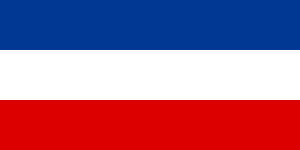Serbia and Montenegro at the Olympics facts for kids
Quick facts for kids Serbia and Montenegro at theOlympics |
|||||||||
|---|---|---|---|---|---|---|---|---|---|
 |
|||||||||
| IOC code | SCG | ||||||||
| NOC | Olympic Committee of Serbia and Montenegro | ||||||||
| Medals |
|
||||||||
| Olympics appearances (overview) | |||||||||
| 2 | |||||||||
| Summer appearances | |||||||||
|
|||||||||
| Winter appearances | |||||||||
|
|||||||||
| Other related appearances | |||||||||
The former state union of Serbia and Montenegro sent athletes to the Olympic Games seven times between 1992 and 2006. After that, Montenegro and Serbia became separate countries.
History
Yugoslavia had sent athletes to every Summer Olympic Games from 1920–1988. They sent athletes to all but two Winter Olympic Games between 1924–1988. Because of the breakup of Yugoslavia in 1991 and 1992, their part in the Olympics changed. Croatia and Slovenia sent their own athletes to the 1992 Winter Olympics. The team from Yugoslavia was made up of athletes from Bosnia and Herzegovina, Macedonia, Montenegro and Serbia. This was the last Games for the Socialist Federal Republic of Yugoslavia.
The Federal Republic of Yugoslavia was created in April 1992. It included the Republic of Montenegro and the Republic of Serbia. In May of 1992, the United Nations Security Council said that all nations should not let the FR of Yugoslavia take part in any international sports. The International Olympic Committee said that athletes from Serbia and Montenegro (and also Macedonia) could still take part in the 1992 Summer Olympics in Barcelona. The athletes had to be Independent Olympic Participants (IOP), wear plan white clothing and use the Olympic Anthem and Olympic flag during the events. They could not be a part of the opening and closing ceremonies of the games. A team of 52 athletes took part in events. They won three medals in shooting. The athletes could only take part in the game as individuals. No teams were allowed. This meant that the men's water polo team, the women's basketball team, and the men's and women's handball teams could not compete.
No athletes were allowed to take part in any way in the 1994 Winter Olympics in Lillehammer. The country was allowed to send athletes to the next Olympiad.
At the 1996 Summer Olympics in Atlanta, Georgia, the team of 68 athletes took part in 13 sports and won four medals. In Sydney for the 2000 Summer Olympics, the Yugoslavia team had 111 athletes in 14 sports and won three medals.
In 2003, the Federal Republic of Yugoslavia became the State Union of Serbia and Montenegro. The nation was named Serbia and Montenegro (SCG) for the first time at the 2004 Summer Olympics in Athens. The team of 87 athletes competed in 14 sports and won two silver medals.
In 2006, the state union ended. Each nation became independent. The NOC for Serbia and Montenegro became the Olympic Committee of Serbia in June 2006. The Montenegrin Olympic Committee was accepted by the IOC in July 2007. Montenegro and Serbia participated independently for the first time at the 2008 Summer Olympics in Beijing.
Related pages
See also
 In Spanish: Serbia y Montenegro en los Juegos Olímpicos para niños
In Spanish: Serbia y Montenegro en los Juegos Olímpicos para niños

